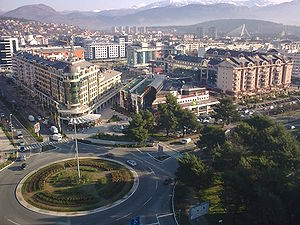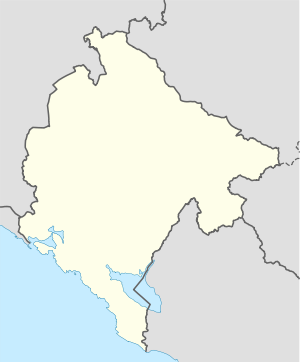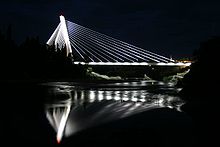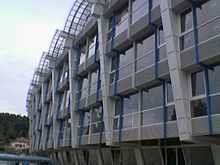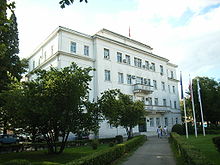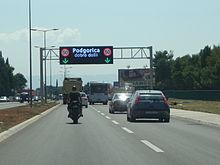- Podgorica
-
Podgorica
Подгорица— City — 
Flag
Coat of armsLocation in Montenegro Coordinates: 42°28′N 19°16′E / 42.467°N 19.267°ECoordinates: 42°28′N 19°16′E / 42.467°N 19.267°E Country  Montenegro
MontenegroMunicipality Podgorica Founded Before 11th century Government - Mayor Miomir Mugoša (DPS) Area - City 144.1 km2 (55.6 sq mi) Elevation 44 m (144 ft) Population (2011) - Urban 156,169 - Metro 187,085 Demonym Podgoričani Time zone CET (UTC+1) Postal code 81000 Area code(s) +382 20 Twin Cities - Belgrade  Serbia
Serbia- Moscow  Russia
Russia- Skopje  Macedonia[1]
Macedonia[1]- Tirana  Albania[2]
Albania[2]- Yerevan  Armenia[3]
Armenia[3]- Zagreb  Croatia
Croatia- Manokwari  Indonesia
IndonesiaLicense plate PG Website http://podgorica.me/ Podgorica, Podgorica (pronounced [pɔ̝̌dgɔ̝ri̞t͡sa]; UK: /ˈpɒdɡɒrɪtsə/, US: /ˈpɑːdɡɔːritsə/,[4] POD-gorr-ee-tsə; Montenegrin: Podgorica, Подгорица, lit. "under the small hill"), is the capital and largest city of Montenegro.
Podgorica's favourable position at the confluence of the Ribnica and Morača rivers and the meeting point of the fertile Zeta Plain and Bjelopavlići Valley has encouraged settlement. The city is close to winter ski centres in the north and seaside resorts on the Adriatic Sea.
A census in 2011 put the city's population at 151,312. The Podgorica municipality contains 10.4% of Montenegro's territory and 29.9% of its population. It is the administrative centre of Montenegro and its economic, cultural and educational focus.
Contents
Etymology
The name Podgorica means "under the Gorica" in Montenegrin language. Gorica (meaning "little hill" or hillock) is the name of the cypress-covered hill that overlooks the city centre.
Some three kilometres (1.9 miles) north-west of Podgorica lie the ruins of Doclea, a town known in Greek, pre-Roman and Roman times. The Roman Emperor Diocletian came from this region. In later centuries, Romans "corrected" the name to Dioclea, guessing wrongly that an "i" had been lost in vulgar speech. "Duklja" is the later (Slavic) version of that word.
When founded (before the 11th century), the town was called Birziminium. In the Middle Ages, it was known as Ribnica (pronounced [rîbnit͡sa]). The name Podgorica was used from 1326. From 1946 to 1992, the city was named Titograd ([tîtɔgraːd]) in honor of Josip Broz Tito, the former President of Yugoslavia.
History
 Sahat kula, an Ottoman clock tower, one of the very few Ottoman landmarks that survived WW2 bombings
Sahat kula, an Ottoman clock tower, one of the very few Ottoman landmarks that survived WW2 bombings
Podgorica is at the crossroads of several historically important routes, near the rivers Zeta, Morača, Cijevna, Ribnica, and Sitnica, in the valley of Skadar lake and near the Adriatic Sea, in fertile lowlands with favourable climate. The earliest human settlements were in prehistory: the oldest physical remains are from the late Stone Age. In the Illyrian age, the area between the Zeta and Bjelopavlići valleys was occupied by two Illyrian tribes, the Labeates and the Docleats. 3 kilometres (1.9 mi) northwest of today's Podgorica and which reflected the local terrain. The population of the city was 8,000-10,000, in which all core urban issues were resolved. The high population density (in an area of about 10 km/6 mi radius) was made possible by the geographical position, favourable climate and economic conditions and by the defensive positions that were of great importance at that time.
From the 5th century, with the arrival of the first Slavic and Avar tribes and the beginning of the break-up of the Roman Empire, the area bore witness to many noteworthy events. With time, the fortifications ceased their function and new towns were built. Slavic groups in the area were in constant war with Byzantium and tended to establish a new state. The result was establishment of a new settlement that was probably named after the river Ribnica on whose banks it was built. The first mention of Ribnica is during the rule of the Serbian royal family of the Nemanjići. The importance of Ribnica was its position as crossroads in communications with the west. In occupying these areas, the Slavs created a new state and developed their own culture and art, acceptable to the mediaeval church and feudal class.
The name Podgorica was first mentioned in 1326 in a court document of the Kotor archives. The city was economically strong: trade routes between Dubrovnik and the State of Nemanjici, well developed at that time, were maintained via the road that led to Podgorica through Trebinje and Nikšić. As a busy crossroads, Podgorica was a vibrant regional centre of trade and communication. This boosted its development, economic power, military strength and strategic importance. The Ottoman capture of Podgorica in 1474 interrupted its economic, cultural and artistic development. The Ottomans built a large fortress in Podgorica and the existing settlement, with its highly developed merchant connections, became the main defensive and attacking bastion against rebellious tribes. The fortified city, with towers, gates and defensive ramparts, enabled the Ottomans to resist all attacks. In 1864, Podgorica became a kaza of the İşkodra vilayet called Böğürtlen 'blackberry'. It was also known Burguriçe in Albanian.
The Berlin Congress in 1878 annexed Podgorica to Montenegro, marking the end of four centuries of Ottoman rule, and the beginning of a new era in the development of Podgorica and Montenegro. The city developed quickly and became a strong marketplace. The first forms of capital concentration were seen. In 1904, Zetska savings bank, the first significant financial institution, was formed. It would soon grow into Podgorička bank. Roads were built to all neighbouring towns and, in 1902, a tobacco plant became Podgorica's first significant commercial company.
World War I marked the end of dynamic development for Podgorica, by then the largest city in the newly proclaimed Kingdom of Montenegro. Podgorica was occupied, as was the rest of the country, by Austria-Hungary from 1916 to 1918. After the liberation by the allies in 1918, a controversial Podgorica Assembly was held at Podgorica Tobacco Monopoly building. The assembly marked the end of Montenegrin statehood, as Montenegro was merged with Serbia and incorporated in the Kingdom of Yugoslavia. Between the two world wars, the population of Podgorica was about 13,000.
Podgorica suffered heavily during World War II; the city was bombed over 70 times throughout the course of the war and razed to the ground, causing the deaths of over 4,100 people. The city was liberated on December 19, 1944. Under the name of Titograd, the city became the capital of the Socialist Republic of Montenegro on 13 July 1946. A period of unprecedented expansion followed, which marked the SFRY era: the population increased dramatically, the city was heavily industrialized, infrastructure was improved, and health, educational, and cultural institutions were founded. The city rapidly became the commercial, socio-economic and cultural centre of the country. The progress halted again when the break-up of SFRY began in the 1990s. The name of Podgorica was reinstated on April 2, 1992.The destructive Yugoslav wars bypassed Montenegro, but the entire country was greatly affected economically. A period of severe economic stagnation lasted throughout the 1990s. The economy began to recover in the early years of the 21st century, when Podgorica began to emerge as a modern, pro-western city. Following the successful independence referendum in May 2006, Podgorica became the official capital of an independent state, boosting its status as a regional centre and raising its economic prospects.
Geography
Podgorica is located in central Montenegro. The area is crossed with rivers and the city itself is only 15 kilometres (9.3 mi) north of Lake Skadar. The Morača and Ribnica rivers flow through the city, while the Zeta, Cijevna, Sitnica and Mareza flow nearby. This richness in bodies of water is a major feature of the city.
In contrast to most of Montenegro, Podgorica lies in a mainly flat area at the northern end of the Zeta plain. The only exceptions are hills which overlook the city. The most significant is Gorica Hill (107 m/351 ft), which rises above the city centre. The other hills include Malo brdo ("little hill"), Velje brdo ("big hill"), Ljubović, Dajbapska gora and Čardak. In the main, these are too steep for development and thus limit the city's expansion, especially to the north.
Climate
Podgorica has a modified Mediterranean climate with hot, dry summers and cold winters. Although the city is only some 50 km from the Adriatic Sea, an arm of the Mediterranean, the proximity of the Dinaric Alps to the north alters its climate. The mean annual rainfall is 1,600 mm (63 in). The temperature exceeds 25 °C (77 °F) on about 135 days each year and the median daily temperature is 16.4 °C (61.5 °F). The number of rainy days is about 120, and those with a strong wind around 60. An occasional strong northerly wind influences the climate in the winter, with a wind-chill effect lowering the perceived temperature by a few degrees.
Podgorica is particularly known for its extremely hot summers: temperatures over 40 °C (104 °F) are common in July and August. The highest temperature recorded in Montenegro was 44.8 °C (112.6 °F), on 16 August 2007.
Snow is a rare occurrence in Podgorica: it rarely snows more than a few days per year.
Climate data for Podgorica Month Jan Feb Mar Apr May Jun Jul Aug Sep Oct Nov Dec Year Record high °C (°F) 18
(64)20
(68)26
(79)31
(88)33
(91)38
(100)43
(109)46
(115)39
(102)30
(86)23
(73)19
(66)45
(113)Average high °C (°F) 9
(48)11
(52)14
(57)19
(66)24
(75)29
(84)33
(91)33
(91)27
(81)21
(70)15
(59)12
(54)20.6 Average low °C (°F) 2
(36)3
(37)5
(41)9
(48)14
(57)18
(64)21
(70)21
(70)17
(63)12
(54)8
(46)4
(39)11.1 Record low °C (°F) −21
(−6)−20
(−4)−8
(18)0
(32)4
(39)10
(50)12
(54)9
(48)4
(39)−3
(27)−14
(7)−20
(−4)−21
(−6)Precipitation mm (inches) 163
(6.42)179
(7.05)146
(5.75)98
(3.86)105
(4.13)59
(2.32)38
(1.5)51
(2.01)110
(4.33)230
(9.06)213
(8.39)225
(8.86)1,617
(63.66)Avg. precipitation days 13 14 11 10 11 6 5 4 7 11 16 15 123 Sunshine hours 113 124 186 210 248 300 341 341 240 186 120 93 2,502 Source: BBC Weather Service:Podgorica Cityscape
Podgorica's mixture of architectural styles reflects the turbulent history of the city and country: as one régime replaced another, the corresponding style was introduced.
As part of the Ottoman Empire until 1878, Podgorica has many examples of Turkish architecture. The oldest parts of the city, Stara Varoš (Old town) and Drač are typical of this, with two mosques, a Turkish clock tower and narrow, winding streets.
When the city was incorporated to Montenegro, the urban core shifted to the other bank of the Ribnica River, where the town developed in a more European style: wider streets with an orthogonal layout. This part of the city is today traditionally regarded as city centre, and is called Nova Varoš (New town)
During World War II, Podgorica was almost razed to the ground, being bombed over 70 times. After liberation, rebuilding began as in other cities of the communist-ruled SFRY. Mass residential blocks were erected, with basic design typical of Eastern bloc countries. All that part of the city on the right bank of the Morača River was built this way. Even the empty spaces in the city centre were filled with near-brutalist structures, resulting in an unfortunate fusion of old and new. The residential and business blocks of the SFRY era provided ample housing but have been much criticized for their uninventive and grey appearance.[citation needed]
The main contemporary traffic arteries were laid out during this period, which extended the orthogonal street layout of city center, to the south and west. Residential and infrastructural developments in the SFRY era have mostly shaped the layout of today's Podgorica, and accommodated the unprecedented population growth that followed World War II.However, in area surrounding residential blocks, the city expanded in a form of often chaotic urban sprawl, with densely built private lowrise dwellings leaving little space for streets and sidewalks. The trend of sprawling informal settlements was at peak during the 1990s. Efforts have been made since to improve the infrastructure of those settlements, but many problems remain, especially in large lowrise neighbourhoods in north and northeast Podgorica.
A major advance in Podgorica architecture began in the late 1990s and, since then, the face of the city has changed rapidly. Residential and business construction are proceeding rapidly, incorporating contemporary glass-and-steel architectural trends. In an effort to create a recognizable and modern state capital, city officials are routing significant investments in city's public spaces. Thus, the city has gained entirely new squares, parks and monuments. New landmarks include the Hristovog Vaskrsenja orthodox temple and the Millennium Bridge, the main feature of the Podgorica skyline. Podgorica today is transforming rapidly from a featureless town to a modern European capital.
Culture
Entertainment and performing arts
 The Montenegrin National Theatre building
The Montenegrin National Theatre building
Podgorica is home to many Montenegrin cultural institutions and events. It hosts the Montenegrin National Theatre and a number of museums and galleries. The Montenegrin National Theatre is the most significant theatre not only in Podgorica but in all of Montenegro. Podgorica is also host to the City Theatre (Gradsko pozorište), which includes the Children's Theatre and the Puppet Theatre. Although not as rich in museums and galleries as the historic royal capital Cetinje, there are several noteworthy museums:
- The Podgorica City Museum (Muzej grada Podgorice) preserves Podgorica's rich heritage. Founded in 1950, it has four categories: archaeological, ethnographic, historical and cultural-historical. It houses artefacts which date back to the Roman and Illyrian eras.
- The Archaeological Research Centre (Centar za arheološka istraživanja) was founded in 1961. Its mission is to gather, classify, restore and display archaeological sites.
- The Museum of Marko Miljanov (Muzej Marka Miljanova) in Medun shows life in 19th century Montenegro. It is the most significant Montenegrin memorial museum of its kind.
- The Natural History Museum (Prirodnjački muzej) displays specimens of Montenegrin flora and fauna. This museum has no exhibition space of its own, despite many proposals and initiatives to build one.
There is a notable art gallery in the Dvorac Petrovića (Petrović's Castle) complex in Podgorica's largest public park. King Nicholas's castle, Perjanički dom (House of the Honour Guard), castle chapel and surrounding buildings were converted to an art gallery in 1984. Since 1995, it has been part of the Modern Arts Centre (Centar savremenih umjetnosti) and houses approximately 1,500 works of art. The historic Cinema Culture (Kino kultura), which was founded in 1949, was closed in November 2008 due to continuous financial losses it generated. It was the only cinema in the city for 6 decades. The building of the former cinema will be converted to host the Podgorica City Theatre. Shortly after its closure, a Ster-Kinekor (later acquired by Cineplexx) 6-screen multiplex cinema opened at Delta City shopping mall.
A significant cultural institution of over fifty years' standing is the Cultural-informational centre Budo Tomović (KIC Budo Tomović). It is a public institution which organises various artistic events, including Podgorica's Cultural Summer (Podgoričko Kulturno Ljeto), FIAT – International Alternative Theatre Festival (Festival Internacionalnog Aletarnativnog Teatra), DEUS – December Arts Scene (Decembarska Umjetnička Scena). 'KIC budo Tomović was a host for such names as Tony Parsons or Brooklyn Funk Essentials during their visits to Podgorica.
Media
Podgorica is undoubtedly the media hub of Montenegro. It is home to the headquarters of the state-owned public television broadcaster RTCG. Commercial broadcasters in Podgorica include TV In, NTV Montena, Elmag RTV, RTV Atlas, TV Vijesti and MBC. It was announced that cities local television will be open soon.[5] Their programmes can be received in much of Montenegro.
All Montenegro's daily newspapers (oldest Montenegrin daily newspaper Pobjeda, and Vijesti, DAN) are published in Podgorica, as is the popular weekly magazine Monitor.
Sports
The most popular sports by far are football and basketball. Basketball became especially popular with the success in the late 20th and early 21st centuries of KK Budućnost Podgorica, both in Yugoslav and European competitions.
Football in Podgorica has a very long tradition associated with FK Budućnost Podgorica. World-famous players Predrag Mijatović and Dejan Savićević were born in Podgorica and made their debut in that team. FK Zeta (from the Podgorica suburb of Golubovci) has also reached the former first league of Serbia and Montenegro. These clubs, along with FK Mogren of Budva, usually compete with each other for leading position in the First League of Montenegro. Other clubs from Podgorica and its surroundings play in the Montenegrin First League e.g. FK Dečić (Tuzi), FK Kom and FK Mladost. One of the most popular clubs from the suburbs is FK Ribnica from Konik. The volleyball team OK Budućnost Podgorica and the women's handball team ŽRK Budućnost T-Mobile have had significant success in European competition. Budućnost Podgorica is the most important sports club in Podgorica. Its name means Future.
Sporting events like the annual Podgorica Marathon and the Morača River jumps attract international competitors. Podgorica was the host of 2009 FINA Men's Water Polo World League.
Venues
Podgorica has a number of sporting venues; some are under reconstruction and expansion. The main ones are:
- Podgorica City Stadium. When eastern stand is completed, it will have a capacity of 24,000. It is the home of FK Budućnost Podgorica and the Montenegro national football team. It is currently the only venue in Montenegro that complies with FIFA standards for international football matches.
- Morača Sports Center, a multi functional indoor sport facility. It has a capacity of 4,200 seats. It hosted one group of Eurobasket 2005, while other games were played in Belgrade, Vršac and Novi Sad.
Almost every football club in Podgorica has its own stadium, although these are often only fields with small stands or no stand at all.
Other notable venues are the Stadium of Small Sports (Малих спортова стадиум, Malih sportova stadium) under Gorica hill and the sport shooting range under Ljubović hill. There are many other sports facilities around the city, most notably indoor soccer fields.
Economy
Podgorica is not only the administrative centre of Montenegro but also its main economic engine. Most of Montenegro's industrial, financial and commercial base is in Podgorica. Before World War I, most of Podgorica's economy was in trade and small-scale manufacture – an economic model established during the long rule of the Ottoman Empire. After World War II, Podgorica became Montenegro's capital and a focus of the rapid urbanisation and industrialisation of the Yugoslav era. Industries such as aluminium and tobacco processing, textiles, engineering, vehicle production and industrialised wine production were established in and around the city. In 1981 Podgorica's GDP per capita was 87% of the Yugoslav average.[6] The Yugoslav wars, and the dissolution of Yugoslavia left Podgorica's industries without markets, suppliers or funds to invest and modernise equipment. This led to a decline of many factories, some of which closed down. Those surviving were privatised and have now largely recovered. The Podgorica aluminium smelter (Kombinat aluminijuma Podgorica – KAP, owned by Rusal) and AD Plantaže (a wine and brandy making company) are still among the biggest companies in Montenegro.
In the early 2000s, Podgorica's financial and service sector expanded rapidly and its economy became more service-oriented. The Montenegro Stock Exchange is situated in the city, as well as most Montenegrin banks' headquarters. Economic activity in Podgorica has mostly shifted from heavy industries to telecommunications, construction and banking. Investors and foreign companies which open outlets in Podgorica add significantly to the growth and diversification of its economy. As a side effect, the prices of property and development land in the centre of Podgorica have increased greatly. The growth, although somewhat slowed down due to late 2000s recession, is expected to continue, as Podgorica became capital of an independent country in 2006.
Religion
Podgorica is home to three main religious groups : Orthodox Christians, Sunnite Muslims and Catholic Christians
Orthodox Christian population mostly originates from local Serb and Montenegrin population, which accepted Orthodox Christianity in Middle Ages after a major split during The Great Schism. Most of them settled in Podgorica after final defeat of Ottoman Empire and represent major religious group. There are various sacral objects of Eastern Orthodox churches in the City such as St. George church which originates from 13.th century, or Christ's Resurrection Church which is largest temple in the city recently erected. Catholic population mainly consists of local autochthonous Albanian minority as well as Croat minority. Main sacral object for Catholic population located in the Konik neighbourhood is Catholic Church "Hearth of Jesus" constructed in 1966. in Brutalist style which makes this object unique. Other Catholic objects are located in eastern suburb Tuzi. Muslim population originates from Montenegrin and Serb population which converted to Sunni Islam in Middle Ages during Ottoman rule. Most Mosques are located in oriental old town of Podgorica called Stara Varoš.Religious determination in the municipality)2011 census)
Religion Number Percentage Eastern Orthodox 145,575 78,29% Islam 16,275 8,75% Muslims 4,608 2,48% Roman Catholicism 7,947 4,27% Christians 568 0,31% Agnostic 225 0,12% Atheist 3,698 1,99% Other 1,961 1,05% Did not declare 4,583 2,46% Demographics
Although medium-sized by European standards, Podgorica is by far the largest city in Montenegro: almost one third of Montenegrin citizens live there. According to 2011 census, there are 187,085 people in the Podgorica municipality, which includes small towns of Tuzi and Golubovci, while 151,312 people live in the city itself.
Population (city)
Census Population 1948 14,369 1953 19,868 1961 35,054 1971 61,727 1981 96,074 1991 117,875 2003 136,473 2011 151,312 Ethnicity in 2011 (municipality)
Ethnicity Number Percentage Montenegrins 106,642 57.35% Serbs 43,248 23.26% Albanians 9,538 5.13% Muslims 4,122 2.22% Roma 3,988 2.14% Bosniaks 3,687 1.98% Croats 664 0.36% Others 1,222 0.66% Population (municipality)
Census Population 1948 48,599 1953 55,669 1961 72,319 1971 98,796 1981 132,290 1991 179,401 2003 169,132 2011 187,085 According to the census, the municipality of Podgorica is the metropolitan area, while the city of Podgorica represents the urban area.
Politics
The city administration consists of mayor, city assembly and a number of secretariats and administrative bodies which together act as a city local government. The city assembly has 57 members, elected directly for four-year terms. The mayor used to be directly elected for five-year term, but since the new law was introduced in Montenegrin municipalities mayors will be elected by the city assembly and will have to maintain it's support during his term. Separate elections are held for local sub-divisions of Golubovci and Tuzi since it is part of their administrative autonomy inside Podgorica municipality. Constant questions are raised by various politicians over gaining separate municipality status for Golubovci and Tuzi
On local elections held on May 23, 2010, the Democratic Party of Socialists won 28 seats in the municipal assembly (with coalition partners Bosniak Party and Liberal Party), from 29 needed to form a majority. The opposition coalition "For better Montenegro", consisting of PZP, SNP, NOVA and some minor parties won 24 seats. Social Democratic Party of Montenegro, which has won 5 mandates, is in position to decide with whom it will form a coalition. Position of the mayor is held by senior DPS official, Miomir Mugoša, who has been incumbent since 2000.
Local subdivisions
Main article: Subdivisions of PodgoricaThe municipality of Podgorica consists of Podgorica City Proper and two subdivisions called Urban municipalities (Градске општине, Gradske opštine), Golubovci and Tuzi.
The entire municipality of Podgorica is further divided into 57 local communities (мјесне заједнице, mjesne zajednice), bodies in which the citizens participate in decisions on matters of relevance to the local community.
Education
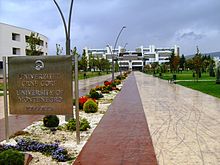 University of Montenegro main building
University of Montenegro main building
Most of Montenegro's higher education establishments are in Podgorica. It is home to the University of Montenegro, the country's most significant such institution. It consists of the following faculties:
- Faculty of Economics
- Faculty of Law
- Faculty of Electrical Engineering
- Faculty of Metallurgy and Technology
- Faculty of Political Sciences
- Faculty of Civil Engineering
- Faculty of Mechanical Engineering
- Faculty of Natural Sciences and Mathematics
- Faculty of Medicine
The University includes four scientific research institutes as well:
- Institute of Foreign Languages
- Institute of Biotechnology
- Institute of History
- Institute of Marine Biology
The Montenegrin Academy of Sciences and Arts is also in Podgorica, as is the DANU cultural organization.
The University "Mediterranean" was founded 2006 as first private university in Montenegro. In the meantime, the number of private institutions for higher education has increased. The municipality of Podgorica has 34 elementary schools and 10 secondary schools, including one gymnasium. The first secondary school established in Podgorica is Slobodan Škerović. The rebuilt economic high school now offers new features and higher quality education. The Radosav Ljumović national library is considered the most comprehensive in Montenegro.
Transport
Public Transport
Public transport in Podgorica consists of bus lines. City owned AD Gradski saobraćaj public transport company used to be the sole bus operator, until the 1990s, when private carriers were introduced. The city-owned company went bankrupt in 2001, and buses were since operated solely by private carriers.
Public transport has struggled to deal with competition. Unlicensed taxis that once threatened the bus services are now extinct, but cheaper despatched taxicab services have become more popular.
The taxicab service is well-organised. Over 20 companies operate over 800 vehicles. These boast a high level of service, including new cars, same car model for entire company, drivers in uniforms and GPS-tracked vehicles.
Road
Podgorica's location in central Montenegro makes it a natural hub for rail and road transport. Roads in Montenegro (especially that which connects Podgorica to northern Montenegro and Serbia) are usually inferior to modern European roads. Both major Montenegrin motorway projects, Bar – Boljare motorway and Adriatic Ionian motorway, will pass near Podgorica. Those roads are currently in planning stages. The newly-built Sozina tunnel (4.2 km) shortened the journey from Podgorica to Bar (Montenegro's main seaport) to under 30 minutes. Also a new road bypass has been constructed in 2011, to remove transportation routes from north to south of the country out of the City center. A south-western bypass has also been planned, with same goal of moving heavy transport out of the City core. Podgorica is also characteristic for its extensive network of 2+2 or 3+3 boulevards which make inner city transport quick and effective. Traffic over the Morača river also goes fluently since both coasts are very well connected with over 5 bridges.
The current main transit connections of Podgorica are:
- north (E65, E80), towards Belgrade and on to Central Europe
- west (E762), towards Nikšić, Bosnia and on to Western Europe
- south (E65, E80) towards the Adriatic coast
- east (E762), towards Albania
Rail
Podgorica is a hub of X-shaped Montenegrin rail network. The Belgrade–Bar line converges with the line to Nikšić and line to Shkodër at the Podgorica Rail Station. The station itself is located 1.5 km (0.93 mi) to the southeast of the main city square. Podgorica's main railway link (for both passenger and freight traffic) is Belgrade–Bar. The link to Nikšić is currently under reconstruction and electrification.,[7] with passenger service expected to start in 2012. The rail link to Shkodër is currently used as freight-only.
Air
Podgorica Airport is 10 km south of the city center located in Zeta Plain and is Montenegro's main international airport. It consists of one terminal and was recently connected to the city with a boulevard. A new passenger terminal was opened on 13 July 2006. Podgorica Airport served over 650,000 passengers in 2010. There are regular flights from Podgorica to Belgrade, Budapest, Frankfurt, Istanbul, Ljubljana, Niš, Paris, Rome, Moscow, Vienna, Zagreb and Zurich.
External links
- Podgorica official website
- Tourism Organisation of Podgorica
- National Tourism Organization of Montenegro
- Visit-Montenegro.com
- Photo-Montenegro.com
- Podgorica – WikiTravel
- Skyscrapercity Podgorica Construction Updates
References
- ^ "Official portal of City of Skopje – Skopje Sister Cities". © 2006–2009 City of Skopje. http://www.skopje.gov.mk/EN/DesktopDefault.aspx?tabindex=0&tabid=69. Retrieved 2009-07-14.
- ^ "Twinning Cities: International Relations" (PDF). Municipality of Tirana. www.tirana.gov.al. http://www.tirana.gov.al/common/images/International%20Relations.pdf. Retrieved 2009-06-23.
- ^ "Yerevan Municipality – Sister Cities". © 2005–2009 www.yerevan.am. http://yerevan.am/main.php?lang=3&page_id=194. Retrieved 2009-06-22.
- ^ Wells, John C.. Longman Pronunciation Dictionary. Pearson Longman. ISBN 9781405881180.
- ^ Mugoša: Podgorica dobija svoju televiziju
- ^ Radovinović, Radovan; Bertić, Ivan, eds (1984) (in Croatian). Atlas svijeta: Novi pogled na Zemlju (3rd ed.). Zagreb: Sveučilišna naklada Liber.
- ^ U Željeznicu ulažu 52 miliona eura
Andrijevica · Bar · Berane · Bijelo Polje · Budva · Cetinje · Danilovgrad · Herceg Novi · Kolašin · Kotor · Mojkovac · Nikšić · Plav · Pljevlja · Plužine · Podgorica · Rožaje · Šavnik · Tivat ·
Ulcinj · Žabljak
Capital cities of the Candidate Countries of the European Union  Categories:
Categories:- Podgorica
- Capitals in Europe
- Populated places in Montenegro
- Municipalities of Montenegro
Wikimedia Foundation. 2010.

